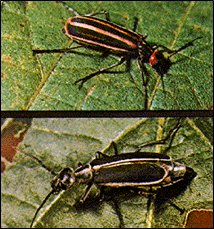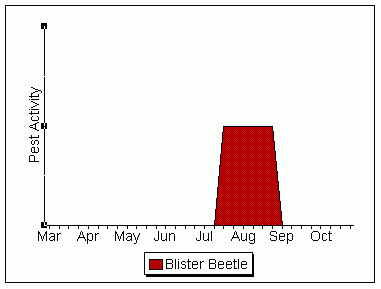Blister Beetle in Alfalfa
Blister Beetle
Description

Top - Striped blister beetle
Bottom - Margined blister beetle
Three species of blister beetles are common in Kentucky. Groups of them may be found feeding on flowering weeds and alfalfa from mid-July through August. They are long beetles with cylindrical bodies and soft wing covers. Common species include the black blister beetle, as well as the margined blister beetle and striped blister beetles (shown in pictures at right). They are active from mid-July through August and tend to occur and feed in groups.
Damage
Blister beetles do not harm the crop but are a potential problem if eaten by livestock. If the beetles are trapped and crushed in hay during harvest, the defensive chemical contained in their bodies can make cattle sick or kill horses. There is no way to detect beetles in cured hay so prevention is the best option.
IPM Techniques and Scouting Procedures
- These insects feed on flowers so field checks are needed only when alfalfa or weeds are blooming.

Black blister beeetle
- Use a 15" sweep net to sample areas of the field that are in bloom, or check the areas visually. The beetles can be seen easily on the flowers.
- If beetles are present, cut the hay without crimping it or running it through a conditioner. As long as they are not crushed, the beetles will fly out of the field as the hay cures and will not be present in the bales.
- There are no thresholds for these insects but their presence in the field should be reported to the farmer and supervisor.
Blister Beetle Activity

Please note: These dates are approximations only. This calendar was constructed using data from Kentucky, USA. These dates may not apply in your area. You may wish to contact your county extension agent or agricultural consultant for information tailored to your locality.
References and Additional Information
- IPM-1 Kentucky Alfalfa IPM Manual
- ENTFACT 102 - Blister Beetles in Alfalfa


